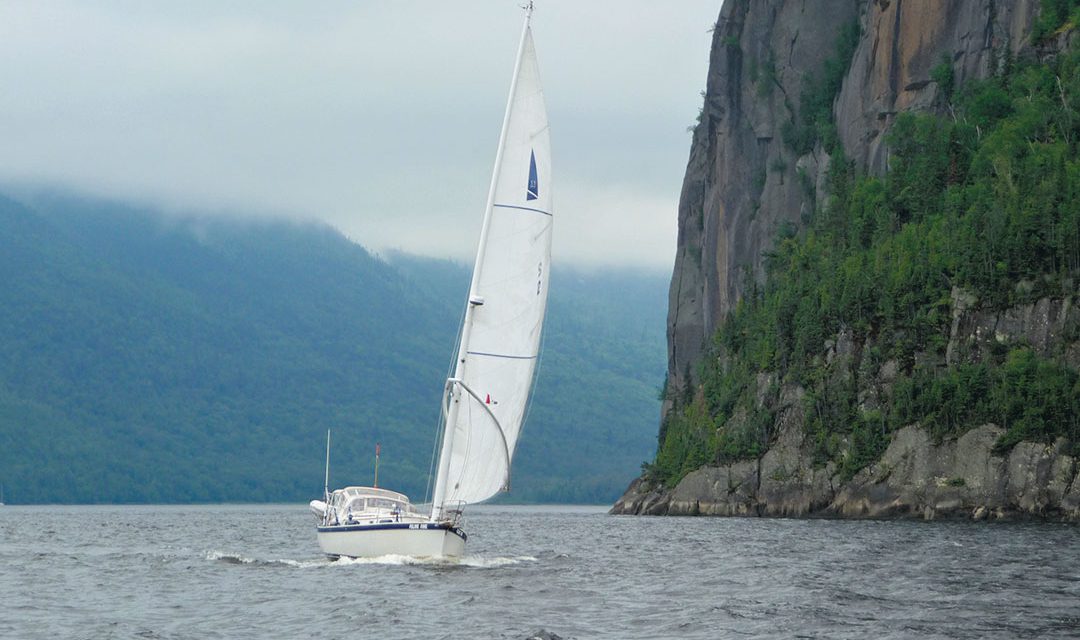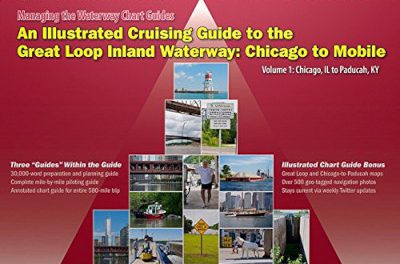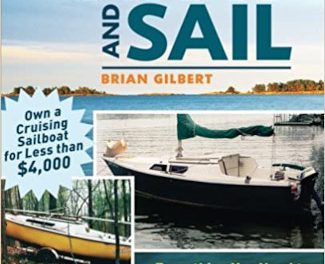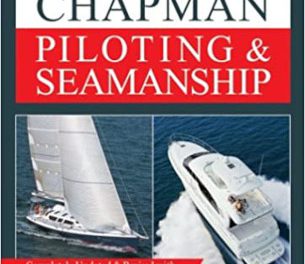Freestanding rigs offer an intriguing comparison to traditional, stayed masts.
Issue 134: Sept/Oct 2020

Feline Fine, a Nonsuch 30 out of Quebec City, sails up the Saguenay River from Tadoussac.
In 1985, when I joined the office of Mark Ellis Design, Mark took me sailing aboard a Nonsuch 30 called Lotus. He wanted to demonstrate the Nonsuch and the advantages of its unstayed, freestanding rig. With Mark sailing the boat entirely on his own, we charged upwind in a nice breeze, tacking at will with just his simple turning of the wheel. Then we went off on a reach with the main eased but with just a comfortable amount of weather helm. But the real revelation came when we turned downwind. Mark simply eased the main out beyond 90 degrees, with no shrouds getting in the way, allowing us to sail slightly by the lee with no real threat of an accidental jibe.
That day on the water made clear the ways in which a freestanding rig could make sailing easier–hence, more accessible—to many. There are really only two ways to hold a mast upright: support it with wires, or bury its base soundly below decks and build it strong and flexible enough to support itself. The former is the stayed mast, the latter is known as the freestanding mast. And while the freestanding mast has been around for a long time (think junk, lug, or cat rigs), daring innovators of the 1970s, including Mark Ellis, began to mate a freestanding mast to modern hulls. The result was a rig that offered benefits (and a few drawbacks) compared to boats with stayed masts. But there’s more to understanding freestanding rigs than weighing the pros and cons—lots more.
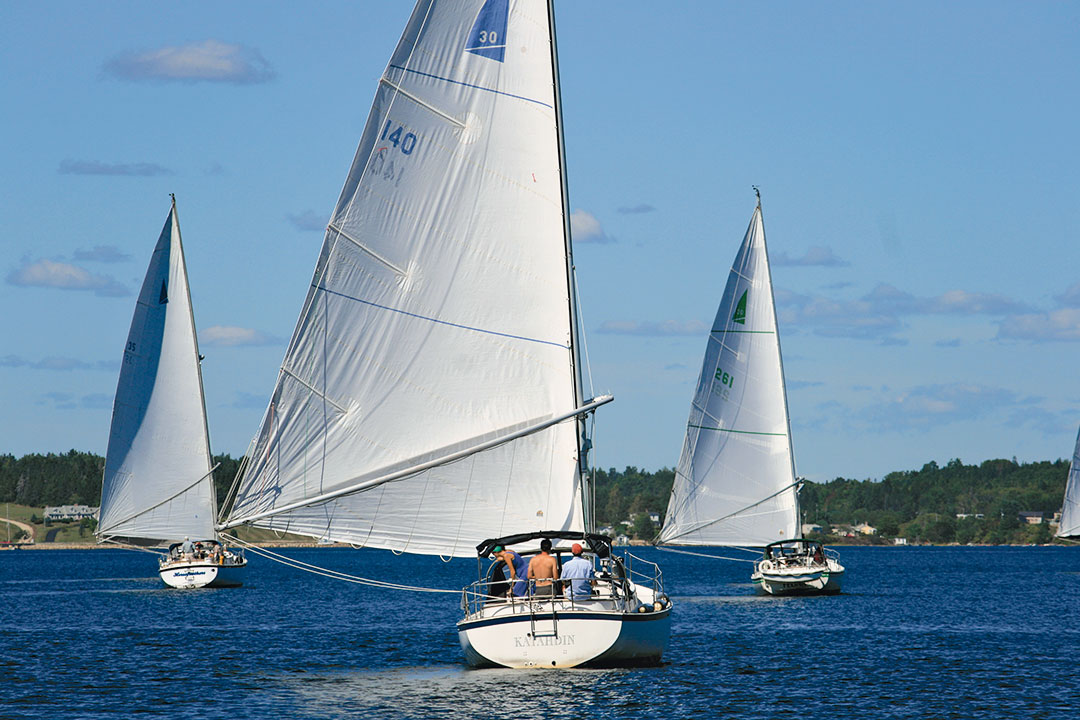
A flotilla of Nonsuches sails off the wind, highlighting the ability to ease the main as much as desired, unimpeded by shrouds. Imagine sailing by the lee without the imminent possibility of an accidental jibe.
What’s Old Is New
While both freestanding and stayed masts have been around as long as there have been sailboats, stayed rigs have vastly outnumbered freestanding rigs throughout western and European history. The only boats that have consistently used freestanding masts are those on which the mast was placed so far forward in the hull that there was not enough beam to allow the installation of chainplates and shrouds. That applied specifically to catboats, on which the mast was located as far forward in the boat as possible to set one large single sail—think Gloucester, the subject of Winslow Homer’s famous oil on canvas, “Breezing Up (A Fair Wind),” which he painted in the 1870s.
One hundred years after Homer’s lovely work, along came Gary Hoyt’s Freedom 40 in 1976, rigged as a cat ketch using two freestanding rigs of almost equal height. Other Freedom designs followed, and then in 1978 came the Nonsuch 30, a boat with a mast so far forward that its design is predicated on the same criteria as Homer’s Gloucester: lack of beam to install chainplates. (The 30 was soon followed by the 26, 36, 22, 33, and the cat ketch Nereus 40, all originally with spun-tapered aluminum masts.)
The inspiration behind the Nonsuch 30 was noted Toronto yachtsman Gordon Fisher, who worked closely with Ellis to realize Fisher’s vision of a boat that was simple to sail with minimum crew. Fisher had owned several CCA and IOR racers and had become disillusioned with their complexity, cost, and difficulty to sail. He sought a simpler approach.
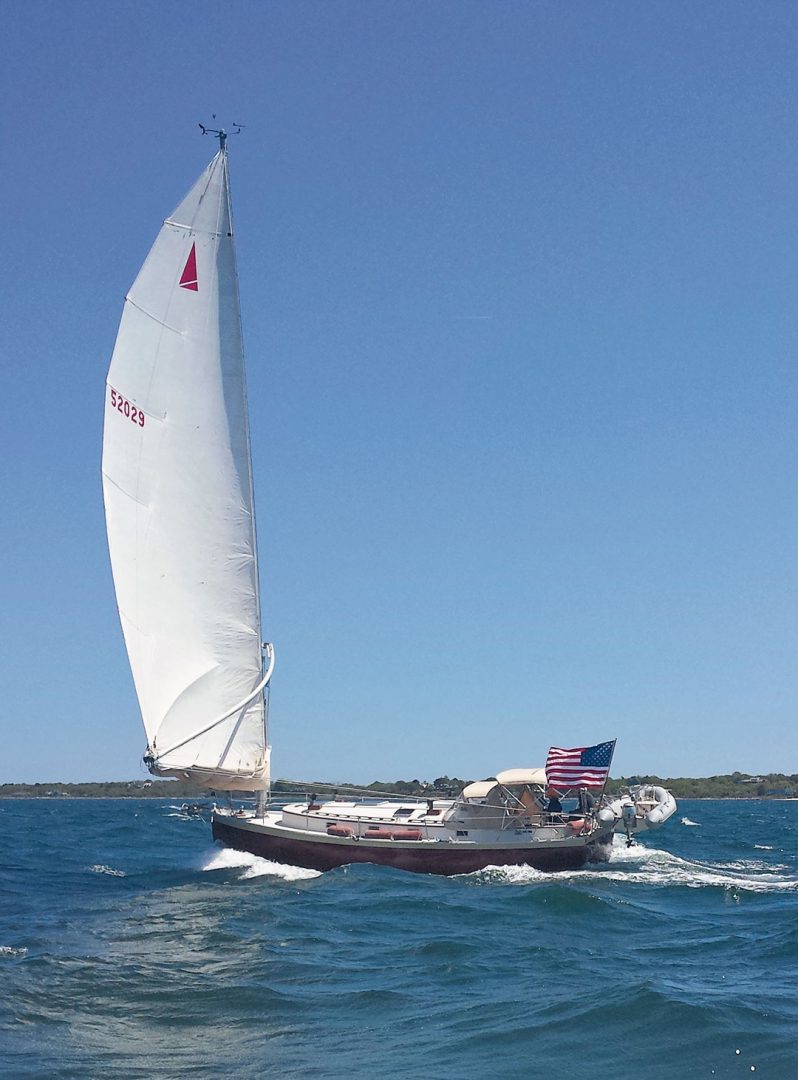
Banshee, a 1988 Nonsuch 36, shows off the self-vanging charateristics of the wishbone boom when sailing downwind, and the ability of the sail to be eased as far as desired without the hindrance of shrouds.
While Freedom started with an innovative, cat ketch, freestanding rig atop a hull with a shoal-draft, full keel with a centerboard, Nonsuch perched a traditional East Coast catboat design atop a modern hull with separate keel and rudder. As with all catboats, the freestanding mast for the single sail was located well forward. The primary improvement on the traditional gaff-rigged catboat configuration was to introduce a more flexible, tapered aluminum mast to support a single high-aspect-ratio sail, combined with a hull shape and keel configuration that did not build weather helm with heel angle, so prevalent in the traditional, wide-beam, centerboard catboat. A wishbone boom meshed with the desire for simplicity, self-vanging as it is. (The wishbone angle was increased on all Nonsuch models that followed the 30 to take greater advantage of its self-vanging characteristic.)
My sail with Mark aboard the jib-less, stay-less Lotus was eye-opening, and when we came off the wind, I realized that if the mainsheet were long enough, we could ease the main until it was streaming directly downwind. But surely, jibing such a large single sail would be a handful?
Yes and no—and again, history provided a guide.
The 19th-century sloops on the Hudson River, sailed by a man and a boy, developed a jibing technique that involved turning the boat over 90 degrees through the jibe so that when the main came around, it would have a soft landing and even luff slightly on what was now slightly closer than a beam reach. Once the main was on the new jibe, the course could be adjusted to downwind.
This maneuver is not for the faint of heart, but we performed the Hudson River jibe several times without incident. It was quite a demonstration of the ease-of-sailhandling advantages of the freestanding rig.
With the feasibility and success of mating freestanding rigs to modern hulls and sail plans established, other designers and companies followed Freedom and Nonsuch. Designer Yves-Marie Tanton drew his take on the freestanding rig for Offshore Yachts, a line that began with the 44 in 1980, all built by Ta Chiao in Taiwan. Eric Sponberg also designed many boats with freestanding rigs, parlaying the engineering experience he derived from working at Tillotson-Pearson, builders of the carbon-fiber masts used by Freedom.
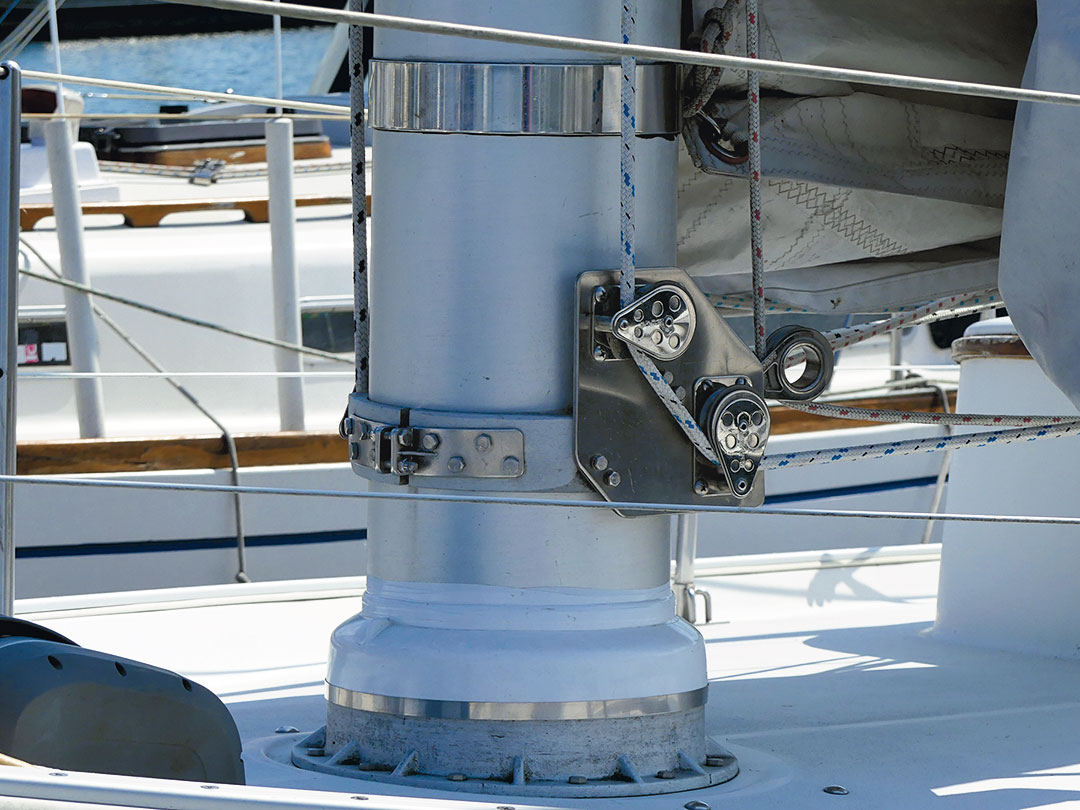
To avoid the stress concentrations and potential fatigue cracks associated with holes drilled into the mast wall, later Nonsuch masts attached the required halyard deflection block, wishbone “choker” tackle, and reef blocks to stainless steel and aluminum bands clamped around the mast, as shown on this Nonsuch 30. Note that even the lower end of the sail track is held in place with strapping. Note also the robust mast collar to take the high sideways load induced by the cantilevered freestanding rig.
Design Considerations
To deepen our understanding of these fundamentally different philosophies in rig design, let’s start by understanding the primary difference between a modern freestanding mast and conventional stayed mast. To be freestanding, a mast must be stepped through a substantial collar at deck level and be seated in an equally substantial mast step beneath the cabin sole. In this way, the mast is essentially a cantilevered beam, subjected to bending loads only. To withstand these loads, the mast must be broader at the deck, tapering towards the top, and made of materials that possess the necessary strength and flexibility characteristics.
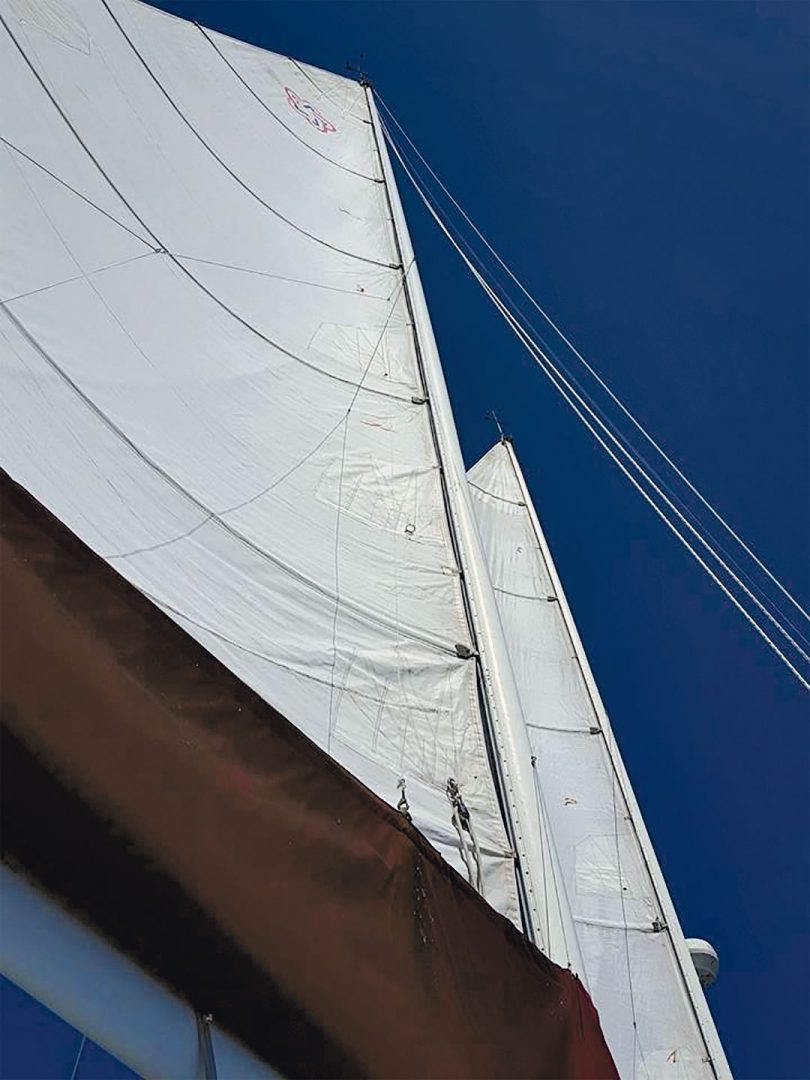
Goodwind, a 1984 Freedom 39 Pilothouse Schooner, features the original Freedom Cat Ketch rig as it evolved with full length battens and conventional booms and vangs.
Stayed masts, on the other hand, are held upright by stays and shrouds. Stays support the mast fore and aft, while shrouds support the mast transversely. Unlike freestanding masts, stayed masts can be either stepped on deck or through the deck on the keel, although keel-stepping the mast provides better lower column support. A stayed mast is subject to compression loads—a downward force on the mast column—induced by the tension on the shrouds and stays. If not designed properly, these loads can lead to the column buckling between the support points at the deck and spreaders. Unlike a freestanding mast, on which width tapers with height, the profile of a stayed mast remains essentially uniform over its length.
Sailboat designers have varied means of managing the potential loads on a stayed mast. For example, they can widen the base of the rig by moving the shrouds and chainplates outboard, reducing the total compression load on the mast proportionally. They can introduce more spreaders and shrouds to reduce the length of each unsupported section of column—greatly reducing the risk of buckling (the critical buckling load is inversely proportional to the squared function of length). They can sweep the spreaders aft, inducing some fore and aft support from the shrouds. Those are a lot of factors to consider and balance.
The designer of a boat with a freestanding rig faces fewer such factors, and they are primarily material choice (aluminum or carbon fiber), mast diameter, and mast wall thickness. For example, to reduce the weight of a freestanding mast of a given material, a designer has only to increase the mast diameter and reduce the wall thickness. However, this decision has the detrimental effect of increasing windage—both the overall windage of the mast, as well as the windage that disrupts the clean airflow as it meets the sail luff. In fact, the weight-or-windage dilemma is the reason there are few racing boats, other than one-design dinghies, with freestanding rigs.
A huge advantage of the freestanding mast is its ability to bend, both to absorb forces and control sail shape. The use of mast bend to control sail shape came to the fore in racing dinghies. The Finn, OK Dinghy, and Laser have all shown the benefit of mast bend to flatten a sail in heavy weather, as well as the benefits of the mast falling off to leeward in gusts to spill wind, relieving stress on the boat (and on the hiking helmsman). These dinghies also demonstrated that a single sail could go upwind very well, thank you very much. A jib was not essential.

The design criteria for freestanding and stayed masts are entirely different and reflect the method of loading imposed on the mast—bending or compression. The freestanding mast, being a cantilevered beam, is designed to absorb only bending loads. The stayed mast is designed to withstand compression and buckling loads imposed by shrouds and stays.
Of course, mast bend also became popular in stayed rigs to control mainsail fullness, but the desired bend must be induced with equipment and crew, whereas it happens automatically on a freestanding rig. And mast bend in stayed rigs can be induced only fore and aft, not transversely. Finally, inducing mast bend in a stayed rig immediately takes the mast out of column fore and aft, requiring the use of running backstays to prevent buckling of the column. Compared to a freestanding rig, mast bend in stayed rigs is a complicated affair.
As well, a freestanding mast exerts an entirely different set of forces on the hull it’s attached to. While a stayed mast transfers a tremendous compression load to the mast step and a huge lifting force on the windward chainplate, a freestanding mast exerts none of those forces. Being a cantilever, the freestanding mast is supported in bending by the mast collar (at deck level) and the mast step. Because the mast is essentially a lever (picture a crowbar), with the fulcrum at the deck partners and the sail heeling forces acting at a point well above deck, you can see how great the “prying load” would be on the mast step.
While these forces are intuitive, there is a less intuitive and equally significant force that can be exerted on the hull by a freestanding mast: torsional loads. And the hull of a boat with a freestanding mast must be built to withstand them.
Thanks to its hull shape and low center of gravity achieved with a ballast keel, a sailboat resists heeling. This resistance is called the righting moment. When wind pushes on a sail and that force is transferred to the mast and to the hull, that force is called the heeling moment. If the wind is strong enough, the heeling moment will exceed the righting moment and the sailboat will heel. (As the sailboat heels, the righting moment increases; when the two forces are in balance, the boat will cease further heeling.)
A sailboat’s total righting moment can be considered roughly centered fore-aft, adjacent to the center of gravity and center of buoyancy, in the vicinity of the keel. On a sailboat with a stayed mast, the mast is usually located about the same place, where the hull is beamy enough to attach shrouds. This works well, because the mast is exerting its heeling moment at roughly the same place that the hull is countering with its righting moment.
In the case of the Nonsuch, the mast is stepped well forward of the hull’s righting moment. All good, except that when the forward-positioned mast exerts a heeling moment, that torque is resisted where the righting moment is, which might be, for example, many feet aft of the mast. That torsional or twisting load has to be absorbed by the hull. Nonsuches have a full bulkhead installed immediately aft of the mast to help transfer these torsional loads as well as to prevent hull distortion from the opposing mast collar and mast step loadings.
From an engineering point of view, a freestanding mast is a simpler design problem than a stayed mast with one exception: fatigue loading. Without question, the Achilles heel of aluminum freestanding masts has been metal fatigue, caused by the constant repetition of alternating loads. Compared to their stayed counterparts, freestanding masts are always in motion. With any structure subject to oscillating loads, be it an aircraft wing, bridge, or road sign, the ultimate life of that structure is a function of the loading experienced, the number of oscillating cycles encountered, and the stress concentrations involved. The higher the loading, the fewer cycles can be absorbed before fatigue failure. This inter-relationship between loading, stress concentrations, and the number of cycles all has to be taken into account in designing for fatigue. The key is to keep the working load below what is known as the “fatigue limit.” If that is done, then a long life of well over a million cycles is pretty well assured.
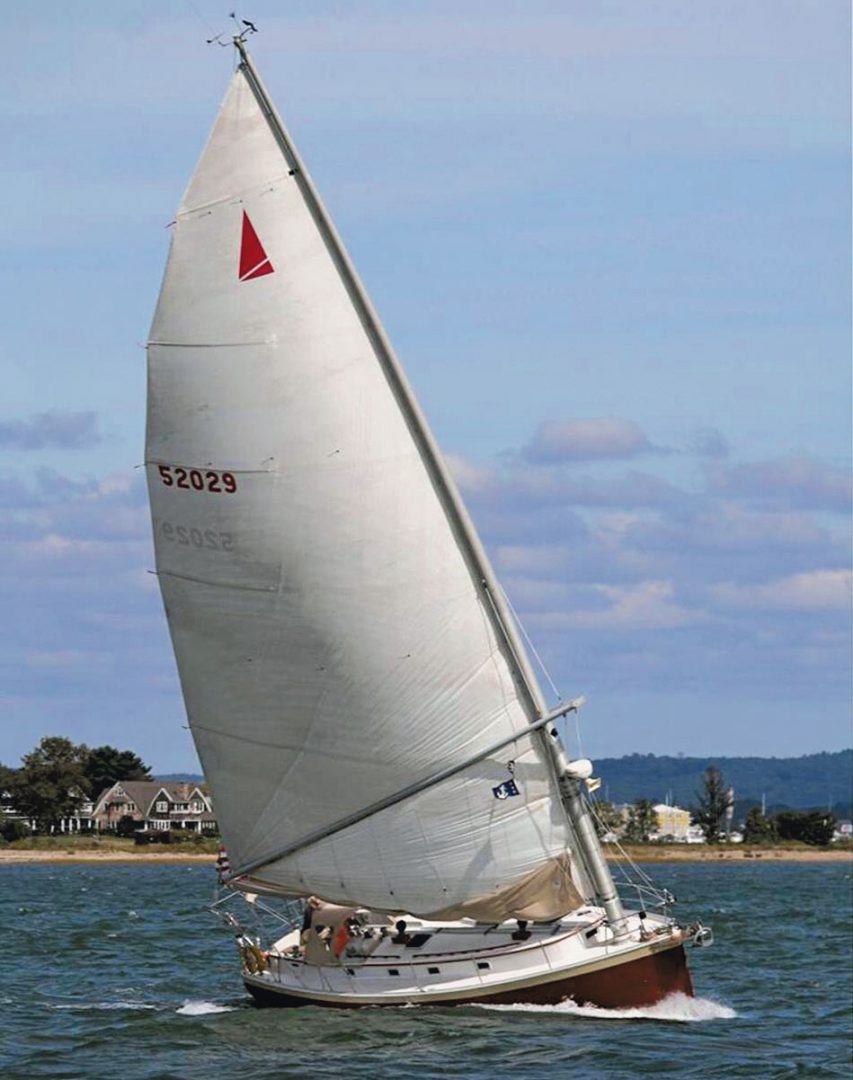
Banshee seems aptly named, pictured here with a bone in her teeth, all of her sail area contained in one large Marconi sail conforming to mast bend. Note the lazy jack lines on this 1988 Nonsuch 36, hanging from the wishbone to contain the sail when it is dropped.
On a heeled Nonsuch, where the mast is a cantilever beam in bending, the weather side of the mast is in tension, while the leeward side is in compression. When the boat tacks, the forces reverse. As the mast pumps in a seaway, the loads fluctuate. Over time, the sides of the mast alternate from tension to compression hundreds or thousands of times depending on how and how often the boat is used. This is classic fatigue loading.
Fatigue loading becomes especially problematic when there are holes drilled in the lower section of the spar. These holes introduce stress concentrations—or stress risers—that can result in fatigue cracks that then emanate from the holes, especially if they have rough edges or sharp corners. A number of early Nonsuch spars failed due to this problem, with fatigue cracks emanating from either the hole drilled for the mast tiedown pin at the mast collar or from the halyard exit. The fasteners at the mast splice were another source of problems, requiring a variety of remedies. Designers eventually figured out that the solution to fatigue failures involved avoiding holes in the mast and ensuring the mast wall thickness was sufficient to extend the fatigue limit. It took a while and involved the redesign and replacement of a lot of mast lower sections, but now aluminum freestanding rigs can be assured of many years of service.
Ultimately, the Nonsuch adopted carbon-fiber masts that had their own stringent requirements for the fastening of hardware and drilling of holes.
Almost 40 years after Mark Ellis impressed me with a sail on Lotus, the majority of sailboat masts are still held upright with wires. Despite their benefits as extolled by their devoted followers, we still don’t see many sailboats with freestanding masts in our marinas. I’m not sure this situation will change anytime soon.
A Term is Born
Eric Sponberg, a naval architect who designed the masts used on several of the boats built by Freedom Yachts, did not like the term “unstayed” applied to these spars. “It sounded too negative,” he says on his website, ericwsponberg.com. “I adopted the term ‘freestanding’ to describe these rigs with no wires holding them up because it sounded like a much more positive term.”
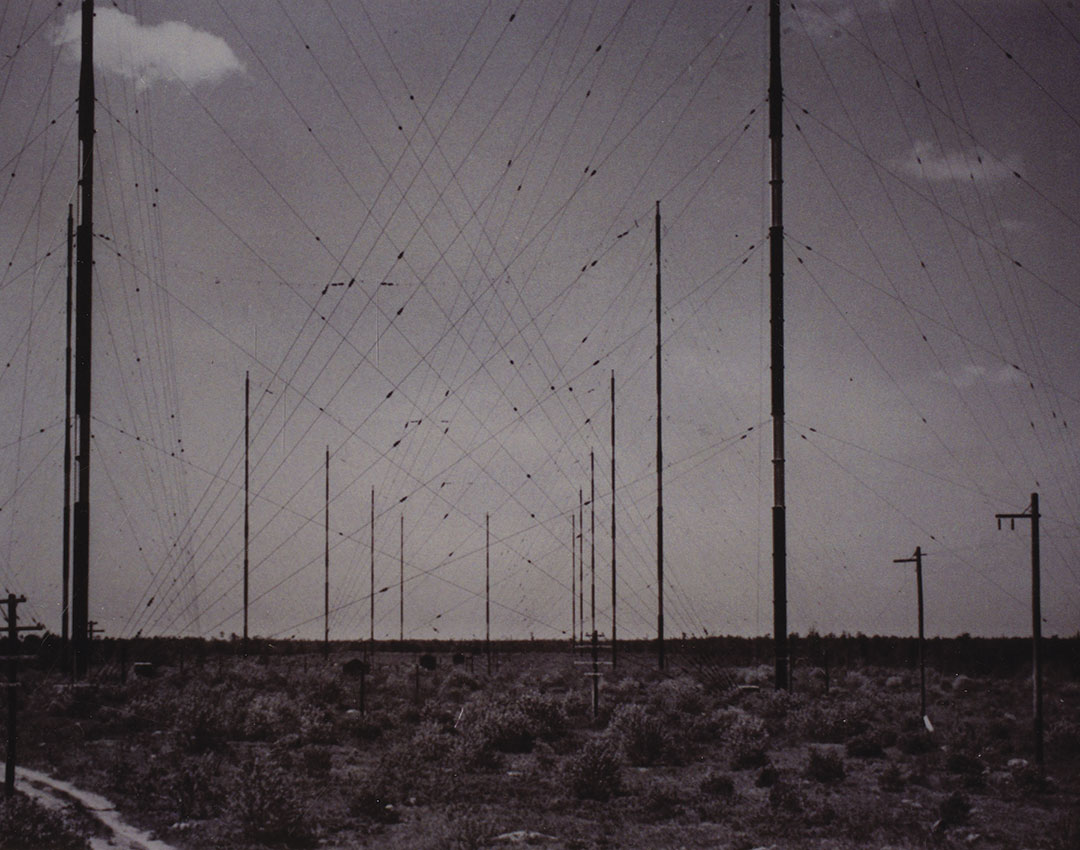
The Marion, Massachusetts, Marconi array, circa 1914. Photo courtesy Sippican Historical Society.
Why Marconi?
It is ironic that the term Marconi rig is used to describe the high-aspect-ratio, triangular sail attached to a tall freestanding spar, such as that on the Nonsuch. The term Marconi rig was introduced in the early 20th century as sail plans transitioned from the traditional gaff rig to elongated higher-aspect-ratio “leg ’o mutton” or Bermuda rigs on tall, single-piece masts. People thought that the large numbers of wires required to support these slender masts resembled the wires supporting the Marconi radio towers springing up all over North America at that time. The term began to apply to the sail shape that these masts could support, rather than the mast itself. The irony is that a sail configuration owing its designation to a large number of supporting wires actually has no wires on the Nonsuch and other freestanding masts. But the designation persists.
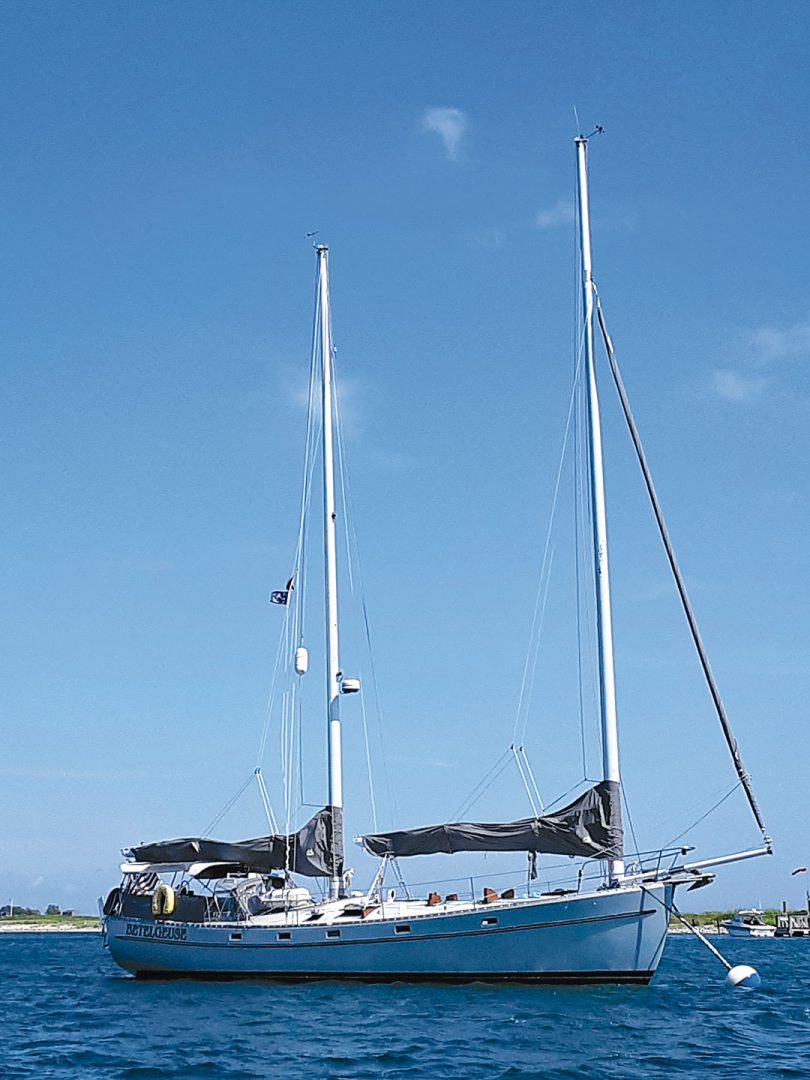
Betelgeuse, a 1982 Freedom 44 Cat Ketch, sitting at her mooring, employs conventional booms and vangs rather than sleeve luffs and wishbone booms as originally used. Her bowsprit is a modification to allow the flying of a jib.
A Single-Sail Precation
In a boat where all or the majority of the sail area is in one sail only, any loss of that sail due to a major tear, headboard failure, or loss of a halyard can be catastrophic—especially when sailing offshore. The primary source of propulsion is lost, with the engine now the only option. That single sail really is putting all the eggs in one basket. When considering the importance of the sail to a freestanding mast, a sailor should think also about the failure points that could affect a crew’s ability to fly the sail, such as the halyard, mainsheet, sail track, and topping lift. In addition, some owners pull their freestanding masts annually to inspect hardware and look for stress cracks.
Freedom 40: The First
The Freedom 40 was the first boat to take real advantage of and popularize the bend characteristics inherent in the freestanding rig. But in addition to its freestanding masts, the Freedom 40 was a platform for other innovations—some successful, others not so much. Among these was a wraparound sail rather than sail tracks to mate the sail with the mast, as well as a wishbone boom straddling the sail and spar, rather than a conventional boom and vang. It soon became obvious, however, that when the wraparound sail got wet it was difficult to lower, raise, or reef. Some earlier Freedoms also experimented—briefly—with rotating masts. Freedom eventually abandoned the wraparound sail and wishbone boom and adopted fully battened sails on tracks with conventional booms. Although the use of the carbon-fiber freestanding rig was, without question, Gary Hoyt’s inspiration and execution, Freedom went through a variety of hull designers including Halsey Herreshoff, Jay Paris, Ron Holland, Dave Pedrick, and Gary Mull (as well as Gary Hoyt himself in the earlier models). The hulls evolved from shoal-draft, full-keel configurations with centerboards to the separate keel and rudders of their IOR sisters. In fact, in Freedom Yacht’s long history under various owners, the only real constant was the commitment to the freestanding rig, with ketches giving way to sloop rigs even in the largest models.
Rob Mazza is a Good Old Boat contributing editor. He set out on his career as a naval architect in the late 1960s, when he began working for Cuthbertson & Cas¬sian. He’s been familiar with good old boats from the time they were new and had a hand in designing a good many of them.
Thank you to Sailrite Enterprises, Inc., for providing free access to back issues of Good Old Boat through intellectual property rights. Sailrite.com

